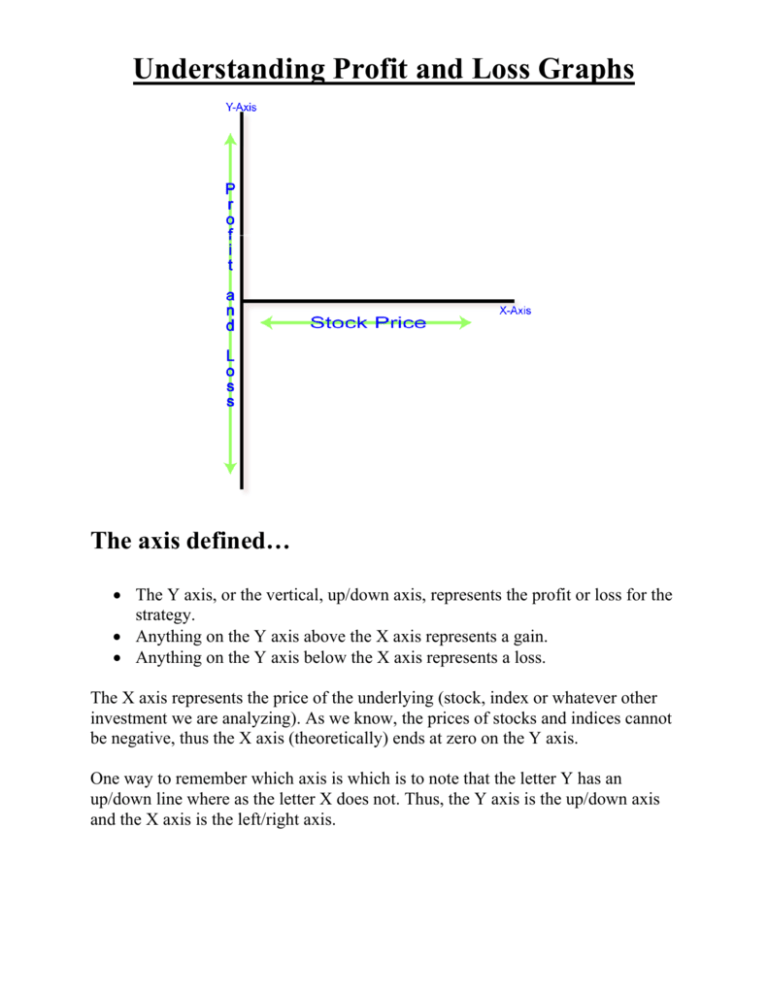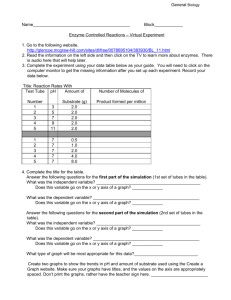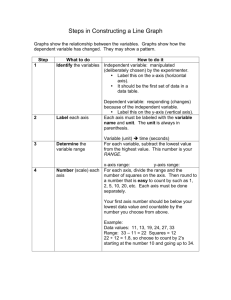Understanding Profit and Loss Graphs
advertisement

Understanding Profit and Loss Graphs The axis defined… The Y axis, or the vertical, up/down axis, represents the profit or loss for the strategy. Anything on the Y axis above the X axis represents a gain. Anything on the Y axis below the X axis represents a loss. The X axis represents the price of the underlying (stock, index or whatever other investment we are analyzing). As we know, the prices of stocks and indices cannot be negative, thus the X axis (theoretically) ends at zero on the Y axis. One way to remember which axis is which is to note that the letter Y has an up/down line where as the letter X does not. Thus, the Y axis is the up/down axis and the X axis is the left/right axis. Why are profit/loss graphs useful? Profit and loss graphs help visualize how a certain options strategy may perform over a variety of prices. These graphs help us understand our gain or loss potential for a given strategy. Profit/loss graphs also help replicate various positions with options. For example, how to replicate the gain/loss profile for a long stock position with a particular option strategy (long call coupled with a short put). These graphs also have proven helpful in naming certain strategies because of the way the graph appears. For example, one complex option strategy, the butterfly spread, is named because the shape of the profit/loss graph resembles that of a butterfly. Profit and Loss diagram for a long stock position of 100 shares Reviewing the above graph for the gain/loss potential for a long stock position, we can identify a few features that assist us in furthering our understanding of these graphs for various option strategies. We will use an example of buying 100 shares of stock for $30 or total out-of-pocket cost of $3,000. This corresponds to point B on the graph. We have not made or lost anything yet, so this corresponds to zero on the Y axis. If the stock price increased to $50 a share, this translates to a profit of $2,000 or point A on the red line. If the stock price declined by $20 a share to $10, we would have a loss of $2,000. This corresponds to point C. As the stock price can only go to zero, our downside loss is limited to -$3,000 (the amount of our initial investment), which explains why the red line ends on the Y-axis at -3,000. In theory, there is no upper limit on a stock’s price. The red arrow increases to the upper right of the graph indefinitely because a stock’s price can, in theory, rise infinitely. Please note we have not factored in any commissions or other brokerage fees and these could potentially have a significant impact on any profit or loss. We can now simplify our graph to show the gain/loss potential for a single long stock position as follows: Long option positions Looking at a profit/loss diagram for a long option position, we get a picture of how the strategy may perform under various stock prices. Look at the long call graph below for a call option with a $50 strike price and a cost of $200. Our downside risk is limited to the premium paid plus commissions. Our maximum loss is the $200 premium. Therefore, the red line intersects the Y-axis at -$200. If the underlying stock price was $50 at expiration, our option would be worthless and we would have lost $200 (point C). The breakeven stock price at expiration for the long call option is $52 (point B). At $52, our gain or loss is zero. Remember we are not referring to the option’s intrinsic value, only our gain or loss for overall the position. As the stock price increases beyond $52, at expiration, we make $1 for every $1 increase in stock price. At point A, we have a profit of $200. Once again, we can now remove all the numbers and simplify the graph for a long call option position as seen below. Now look at the graph below representing a long put option with a strike price of 50 and for which we paid $2.00. As with other long option strategies, our maximum loss is the premium paid to establish the position (point C). At a stock price of $48, we have not made or lost anything. This is our breakeven price (point B). Should the stock price decline to $46 per share at expiration, our gain would be $200 (point A). Our maximum gain is not seen on this graph (we would have to expand it). Our maximum gain would be to the upper left with the stock price at zero and would be equal to the strike price times 100, less our premium. As with our other graphs, we can simplify the long put graph as seen below. In summary, profit and loss diagrams have proven useful for a visual representation regarding the gain and loss potential for various option strategies. Furthermore, when using these diagrams, we get a better understanding of how to replicate the gain/loss profile of different investment strategies using options. This can be useful to further understand and visualize many investment strategies. These simple graphs represent the profit and loss potential, at expiration, assuming the positions are closed at their intrinsic value, if any. As with any investment strategy, you should consider and understand all of the risks associated with that particular strategy and how it fits into your objectives, risk profile and portfolio prior to making an investment decision. Now that we have an understanding of diagrams, the possibilities are nearly endless. Here are a few common option strategies and their gain/loss potential explained by the profit and loss diagrams.









